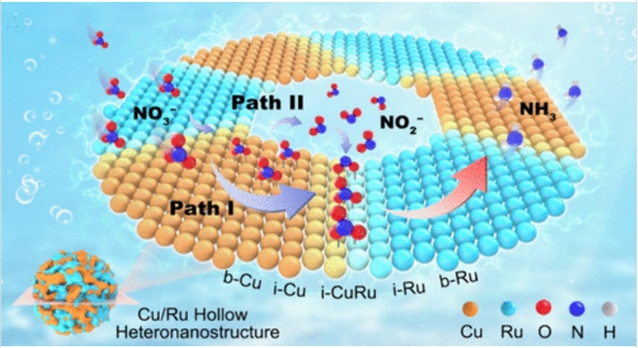
近日,重庆大学黄建峰团队研究了基于Kirkendall效应的Cu/Ru异质界面壳纳米空腔高效硝酸电还原制氨。相关论文于2025年9月29日发表在《美国化学会志》上。
电化学硝酸盐还原合成氨技术既能实现可持续的氨合成,又可有效治理硝酸盐污染。然而,由于多步质子耦合电子转移过程动力学缓慢及中间体转化效率低,实现高效的硝酸盐-氨转化仍面临挑战。
研究组成功研制了一种具有中空纳米腔结构的纳米催化剂,其外壳富含铜/钌异质界面。该设计协同利用界面与结构优势,有效降低反应能垒并加速中间体转化动力学,从而全面提升合成氨的催化性能。通过原位表征、对照实验及密度泛函理论计算证实:具有优化电子结构的铜钌异质界面作为主要活性位点,构建出有利的硝酸盐-氨转化路径;同时铜位点与铜钌位点之间的催化协同效应实现了串联催化,而纳米腔对关键中间体亚硝酸根的空间限域作用进一步强化了这一过程。
该纳米催化剂通过柯肯达尔效应驱动策略制备,其结构特征经过系统优化。在0.1 M硝酸钾+0.1 M氢氧化钾电解液中,该催化剂展现出卓越的合成氨性能:在-0.1 V(相对于可逆氢电极)的低电位下,法拉第效率达97.4%,产率为152.6毫克·小时-1·毫克金属-1,能量效率为40%,其综合性能位居当前最先进的硝酸盐-氨电催化剂前列。通过深入揭示界面效应、串联催化与纳米限域的作用机制,该研究凸显了组分设计与结构工程的协同增效作用,为推进硝酸盐-氨电催化转化及更广泛的可持续催化过程提供了普适性设计策略。
附:英文原文
Title: Engineering Cu/Ru Heterointerface-Shelled Nanocavities by the Kirkendall Effect for Highly Efficient Nitrate Electroreduction to Ammonia
Author: Shuangqun Chen, Zhouhao Zhu, Kepeng Song, Hengrui Zhang, Dan Luo, Tong Cao, Yongtu Zou, Changxu Liu, Liyong Gan, Daliang Zhang, Yu Han, Jianfeng Huang
Issue&Volume: September 29, 2025
Abstract: Electrochemical nitrate (NO3–) reduction to ammonia (NH3) offers a sustainable approach for NH3 synthesis while concurrently addressing NO3– pollution. However, achieving efficient NO3–-to-NH3 conversion remains challenging due to sluggish multistep proton-coupled electron transfer processes and poor intermediate converison. Here, we present a nanocatalyst featuring a hollow nanocavity encased within a shell rich in Cu/Ru heterointerfaces, which synergistically leverages both interfacial and structural advantages to effectively lower energy barriers and accelerate intermediate conversion kinetics, thereby enhancing the overall catalytic performance for NH3 production. Density functional theory (DFT) computations, supported by operando and control experiments, reveal that CuRu heterointerfaces with their optimized electronic structure act as the primary active sites, establishing a favorable NO3–-to-NH3 reaction pathway. Simultaneously, the catalytic synergy between Cu and CuRu sites enables tandem catalysis, which is further amplified by nanocavity-induced spatial confinement of the key intermediate NO2–. This nanocatalyst is realized via a Kirkendall effect–driven strategy, with its structural features systematically optimized. The resulting catalyst demonstrates outstanding NH3 production performance in a 0.1 M KNO3 + 0.1 M KOH electrolyte, delivering a Faradaic efficiency of 97.4%, a yield of 152.6 mg h–1 mgmetal–1, and an energy efficiency of 40% at a low potential of 0.1 VRHE─positioning it as a top contender among state-of-the-art NO3–-to-NH3 electrocatalysts. By elucidating mechanistic insights into interfacial effects, tandem catalysis, and nanoconfinement, this work highlights the synergistic impact of compositional and structural engineering and offers a generalizable design strategy for advancing NO3–-to-NH3 electroconversion and broader sustainable catalytic transformations.
DOI: 10.1021/jacs.5c11097
Source: https://pubs.acs.org/doi/abs/10.1021/jacs.5c11097
JACS:《美国化学会志》,创刊于1879年。隶属于美国化学会,最新IF:16.383
官方网址:https://pubs.acs.org/journal/jacsat
投稿链接:https://acsparagonplus.acs.org/psweb/loginForm?code=1000
